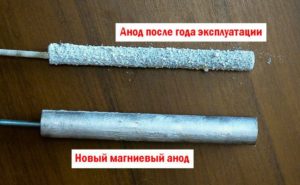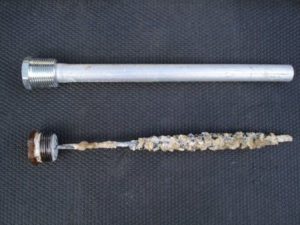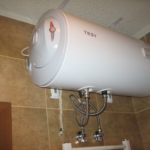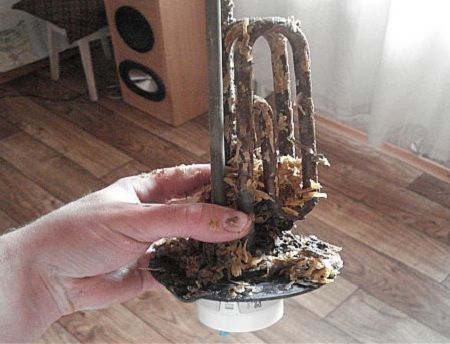Why do you need an anode for a water heater?
Almost any water heating tank contains such an important part as a magnesium anode. Equipment owners most often find out about its presence in the device when they need to clean the container from scale and rust accumulated in it. However, not all of them understand why a magnesium anode is needed and what its real purpose is. You should definitely understand this, since this part is, to one degree or another, responsible for the correct operation of the entire device.
The content of the article
What is it for, what is it?
 The magnesium anode is a special rod made of stainless steel, additionally coated with a layer of magnesium alloy on top. Fixation of this element in the inner part of the containers occurs mainly using a threaded method.
The magnesium anode is a special rod made of stainless steel, additionally coated with a layer of magnesium alloy on top. Fixation of this element in the inner part of the containers occurs mainly using a threaded method.
As a rule, companies use stainless steel, which is an alloy of iron and carbon, to produce water heating tanks. When the water temperature in such containers rises, oxygen appears in them. It is able to interact with the steel elements of the tank, which triggers the formation of oxides. To prevent them from adversely affecting the tank, a magnesium anode is used. It can significantly extend the period of use of the entire device.
Note! Magnesium anode is used to protect the internal enamel of containers, extending their service life.
Constant changes in water temperature cause the tanks to wear out significantly. Cracks may appear in them, which in turn starts the oxidation process. A magnesium anode copes with this problem quite well, preventing it to one degree or another.
Why magnesium
 Many owners of water heating devices often have questions about why magnesium is applied to a steel rod to prevent accelerated corrosion. The need to use this material is due to factors such as:
Many owners of water heating devices often have questions about why magnesium is applied to a steel rod to prevent accelerated corrosion. The need to use this material is due to factors such as:
- Magnesium does not have very high potential;
- magnesium is affordable;
- the use of magnesium is most effective.
Upon contact with magnesium, the salt formed in water does not disappear. In this case, it simply accumulates on the surface of the rod. When its volume becomes too large, a fairly simple and quick replacement of the part is required.
It should be added that if there is an ion-exchange water softener in the house, the magnesium anode begins to stain the water. You have to remove it completely.
Author, don’t write about something you don’t understand.
Magnesium has a VERY high potential - 2.37 V!
Magnesium is non-toxic! therefore it can be used in drinking water.
Magnesium provides anodic protection to the metal of the internal tank of the water heater, and not to the enamel of the internal coating.
Stainless steel is not an alloy of iron and carbon, but an alloy of iron and chromium (the latter must be at least 10%).
As the water temperature increases, the oxygen content in it decreases. Even children and fish in the river know this.






Is the anode protector used to remove salt from water?
These are troubled times, indeed!
Have you heard anything about the electrical potential of various metals?
Are there all sorts of electrons, electrolytes... and other things?